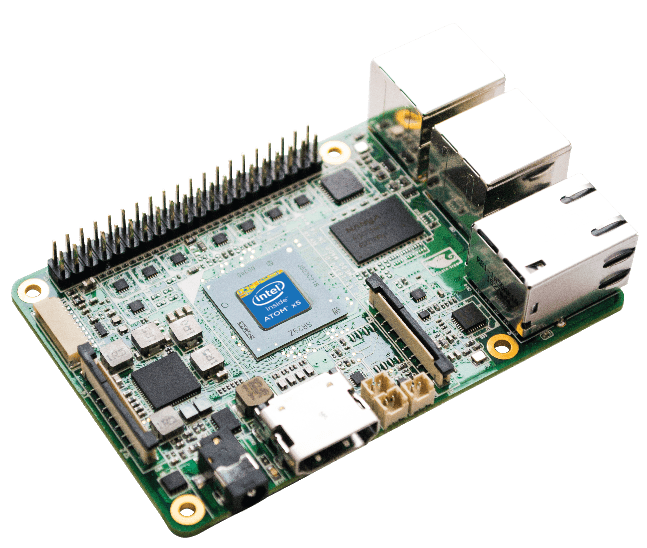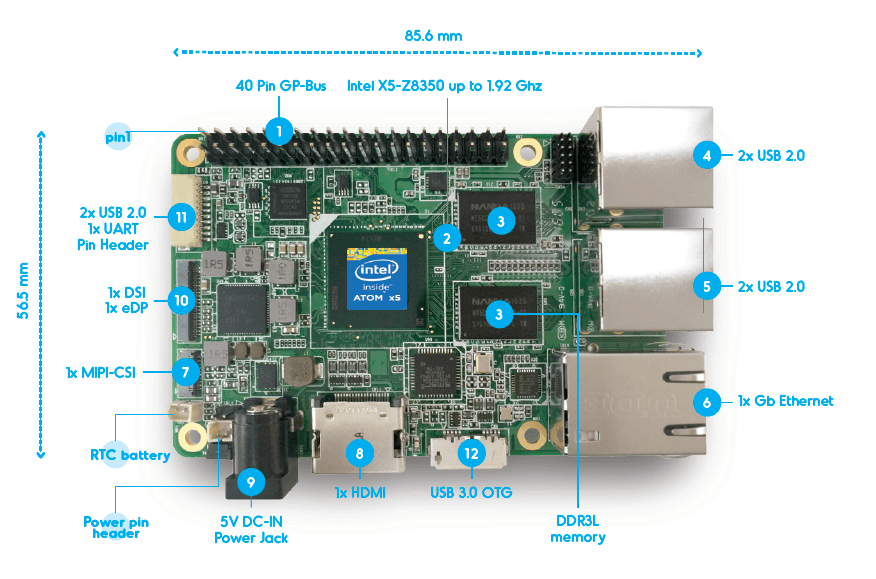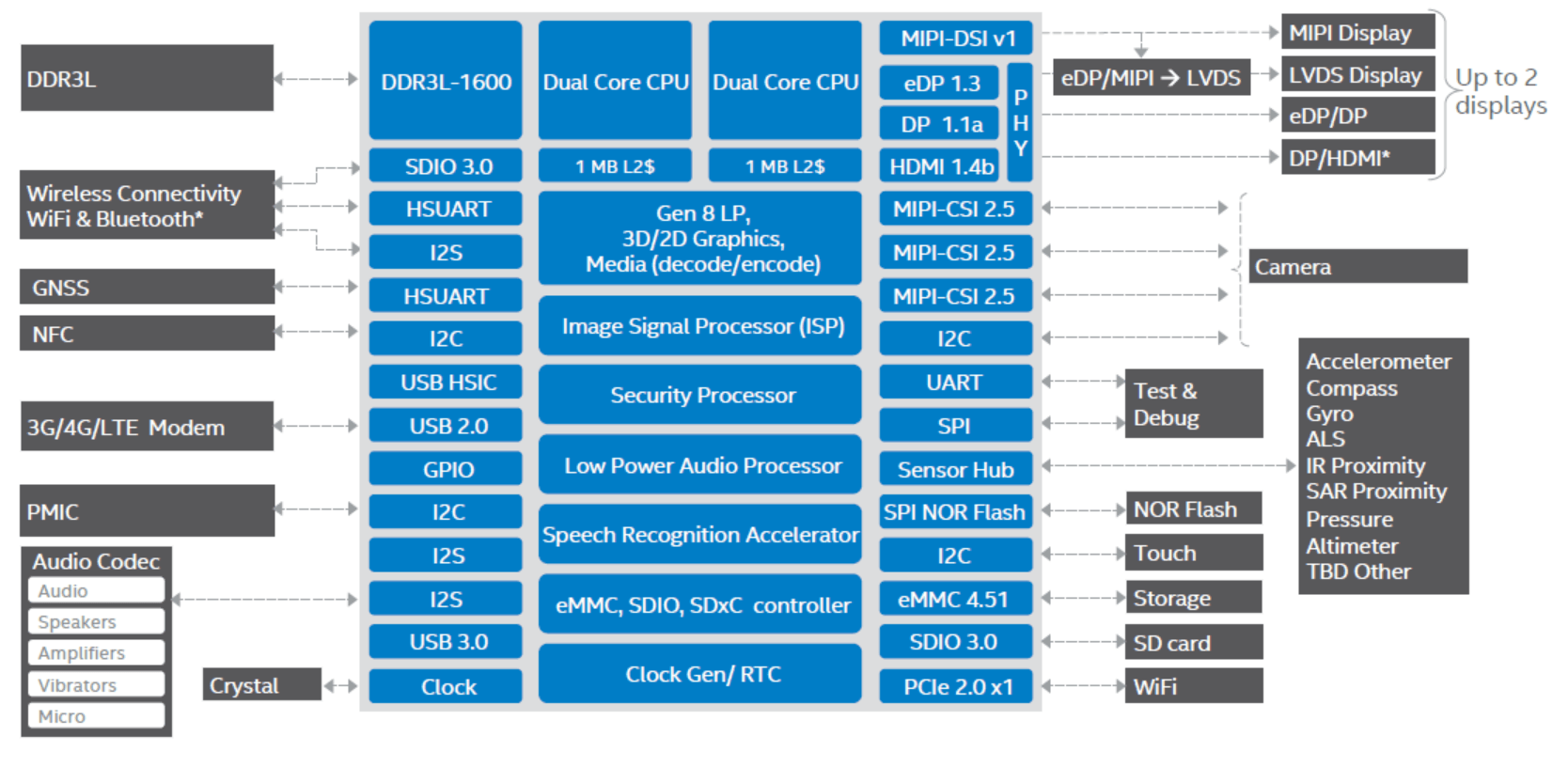A Ferrari in the Raspberry Pi World
A new credit card-size board launched with a Kickstarter campaign provides a powerful new alternative to the Raspberry Pi2, the de facto standard of today’s makers. However, while the UP board shares the same form factor (85.6mm x 56.5mm), it targets the professional maker market. This is readily apparent when you look at its processor. As a press release notes, for a board you can slip into a pocket, the 14 nm four-core Intel® Atom™ processor x5-Z8350 is a “Ferrari” (Figure 1).

Figure 1. The UP board is a Raspberry Pi2 alternative with a powerful processor for its size.
In this post, we look at the performance attributes and other advantages of the new board and its processor.
UP – A Board and an Organization
The board originates from a collaboration of AAEON, Emutex, and Intel, but has now taken on a life of its own as an organization and product line under the name “UP.” A team of independent hardware and software engineers referred to as the “UP Garage Team” have created an UP website and UP community. The team hails half from the industrial electronic market and half from the “makers” market.
The team runs an UP Shop offering different configurations and accessories. Like all Internet of Things (IoT) innovations, innovation is ongoing. The original design featured 1GB DDR3L RAM and 16GB eMMC. The most recent UP designs pack up to 4GB DDR3L and up to 64GB eMMC.
UP bridges the gap between the world of prototypes and the world of high-grade mass-produced embedded systems solutions. AAEON, the industrial embedded company of the Asus group, manufactures the boards in compliance with industrial standards – wide operating temperature, three years’ longevity, CE/FCC Class A certifications, and RoHS compliance. For ODM customers, UP can provide BIOS modifications, depopulated I/O, and system customization. The board is available with a growing selection of accessories, including a 10-inch waterproof touch display and various types of chassis.
The Configuration
For versatility, UP features a 40 GPIO designed to connect a shield with the same connector-and-pin definition of Raspberry Pi2 (Figure 2). UP upgraded its original 40-pin interface by integrating an Altera MAX V CPLD (output DC-current up to 170mA) and an ADC (8bit/189KSPS) to enable a new series of mixed analog/digital applications.

Figure 2. The UP board’s configuration includes a 40 GPIO and other similarities to the Raspberry Pi2.
The MAX V CPLD enables “breadboard-friendly” GPIO features. The MAX V CPLD GPIOs can be re-programmed to change: GPIO-driver strength, slew-rate (fast/slow), Schmitt trigger, internal pull-up and internal clamp diode. Developers can also re-program the MAX V CPLD to integrate “ad-hoc” finite-state machines that reduce the latency of OS/drivers to enable faster response.
The latest board announced on the site features the expanded memory and runs up to two independent displays. The board includes a Display Serial Interface (DSI) and support for both embedded Display Port (eDP) and Consumer Electronics Control (CEC) over HDMI. Other I/O includes 4x USB 2.0 ports on connectors, 2x USB 2.0 ports on header, 1x USB 3.0 On-The-Go (OTG), 1x Gbit Ethernet (full speed), and 1x camera (MIPI-CSI).
A standard industrial PC operating temperature range of 32-104°F/0-60°C makes the UP board a rugged, reliable, and flexible solution for many applications. Other UP board highlights:
- Includes real-time clock (RTC)
- Supports Preboot eXecution Environment (PXe) and Wake-on-LAN
- Runs Windows 8.1, Windows 10 Pro, and Windows IoT Core
- Supports a touch controller part via the USB header
Operating System Choices
Developers can choose the operating system best suited for the application – Android 5.0 Lollipop, Microsoft Windows* 10, or Linux*. All advanced computing features and simple connection interfaces are made available through standard Linux, Windows and Android APIs which are regularly improved and supported by the UP community.
UP is Microsoft Azure Certified for IoT, making it ideal for IoT edge-to-cloud applications. Pre-tested and verified to work with Microsoft Azure IoT services, the board makes it easy to get IoT solutions up and running quickly. The certification opens up an ecosystem of devices and platforms for faster time to production.
Emutex can help get Linux users started through a new build of their ubilinux* distribution. Ubilinux is an embedded Linux distribution based on Debian that is targeted at embedded devices with limited storage capabilities. Emutex provides ongoing support through a proactive ubilinux community.
For makers intending to use UP platforms in IoT solutions, Emutex provides a free version of their ubiworx* software framework. This solution speeds development of sensor-monitoring IoT gateway solutions and cloud connection. For example, using Emutex’s ubiworx IoT software, developers can set up solutions where sensors communicate with the UP board and perform functions such as turning on a light when a switch is pressed or indicating when a door is opened.
A Processor Designed to Keep UP with the IoT
The Intel Atom processor x5-Z8350 is a 1.44 GHz SoC with a 1.92 GHz burst frequency. Launched at the start of 2016, the Intel® Atom™ processor’s advanced processing capabilities make the UP board an excellent choice for applications in robotics, drones, machine vision, Smart Home, education, digital signage, intelligent cars, and IoT in general.
The processor is the latest in the Intel® Atom™ processor x5-Z8300 product family which uses Intel’s latest 14 nm manufacturing process to provide tightly integrated SoCs (Figure 3). A power envelope of 2 W makes this processor family suitable for constrained environments.

Figure 3. This diagram shows the wealth of features integrated into the Intel® Atom™ processor x5-Z8300 product family.
The Intel Atom processor x5-Z8350’s four CPU cores and 2 MB of last level cache enable fast computing and efficient multi-tasking. Intel® Burst Technology dynamically optimizes compute and graphics performance to handle peak loads and deliver lower overall power consumption. Support for 64-bit applications helps deliver higher performance and greater functionality across a wide range of IoT use cases.
The processor’s integrated graphics give the UP board an advantage over boards with lesser graphics and headless designs like the Intel® Galileo board. The processor’s Intel® HD Graphics (Gen 8) features 12 execution units running at up to 500MHz to deliver excellent 3D graphic performance, including 4K video playback. The eye-popping visual experiences and high-quality image capture improve results for visually-intensive IoT applications. Integrated support for hardware-accelerated video transcoding, video conferencing, wireless display connectivity, and the latest graphics APIs (DX11.2, DX12) provide the foundation for flexible, high-quality user experiences on small, lightweight, low-power mobile devices. The processor’s graphics support Open GL*4.2, Open CL*1.2 OGL ES3.0, H.264, HEVC (decode), and VP8.
For security, the processor provides the hardware-enhanced security features needed for professional IoT applications. These features include:
- Intel® AES New Instructions (Intel® AES-NI) – a set of instructions that enable fast and secure data encryption and decryption
- Intel® Identity Protection Technology – a built-in security token technology that helps provide a simple, tamper-resistant method for protecting access to online customer and business data from threats and fraud
Up and Running with UP
For a quick start on new IoT solutions, be sure to check out the UP product line. To shop for other components from a selection of over 5,000 items, visit the Alliance’s Solutions Directory.